After establishing themselves in the Premier League for over a season, Brentford commenced their current form without a single loss but only secured one victory in their first four games.
The absence of Ivan Toney for eight months due to a breach of FA betting rules has left Brentford in a vulnerable position. In response, the club recently bolstered their attack by signing striker Neal Maupay from Everton to strengthen the attack.
This summer, they also acquired centre-back Nathan Collins from Wolves and Kevin Schade from Freiburg, in addition to goalkeeper Mark Flekken, following the sale of David Raya to Arsenal.
In their initial four matches, starting with a 2-2 draw against Tottenham and culminating in another 2-2 draw against Bournemouth, the Bees achieved the highest expected goals (xG) in the league, surpassing the likes of Manchester City, Manchester United, Arsenal and others.
For years, this emerging team has based its strategy on data, with owners utilising it effectively to maximise success — a concept we previously dubbed “The new pragmatism in modern football.”
Despite Raya’s absence, Mark Flekken has seamlessly taken up the role of building play from the back. The Dutch goalkeeper ranks third in attempted passes with 163, just behind Ederson with 182. Flekken also possesses an impressive range, ranking second with 30 passes longer than 40 yards.
Manager Thomas Frank has predominantly relied on a 4-3-3 or 3-5-2. Aaron Hickey’s versatility on the right allows for seamless transitions between these systems, even within the same match. The defence features Collins alongside the experienced Ben Mee while attacking full-back Rico Henry holds the left flank.
Frank has stuck to his usual trio of Christian Nørgaard at the base in midfield, with Vitaly Janelt and playmaker Mathias Jensen. Mikkel Damsgaard, despite arriving a season ago, has struggled to secure a starting spot.
Upfront, Brentford faced challenges due to Toney’s absence, but Thomas turned to Yoane Wissa as the primary striker, flanked by the experienced Bryan Mbeumo and the speedy German winger Kevin Schade, who proved effective in their quick and direct attacking plays.
Ivan Toney is out? Keep swift and direct
Despite missing their star, Brentford currently lead the league in expected goals (xG) with 9.7, while Brighton follow closely with nine, and Manchester City rank third with seven. However, when it comes to converting chances, Brentford lags behind. Brighton has scored 12 goals in four matches, with The Citizens close behind with 11, while Brentford sits eighth with only eight goals.
This scoring challenge is partly attributed to Toney’s absence and the harmony between the new composition in the attack, including Schade. Nonetheless, the team is creating numerous opportunities, reflecting the principles established by Frank in previous seasons.
The Bees’ style revolves around quick and direct play, whether on the ground or in the air. The team organises from the goalkeeper as full-backs push forward, creating wide passing options for penetration. High wingers provide them additional space to advance, and one of the No. 8s in the 4-3-3 drops alongside Nørgaard to form a 2-4-1-3 structure during the build-up.
This season, Mark Flekken’s passing map indicates a focus on right-side penetration, where Aaron Hickey operates. Long balls that Toney typically received have decreased due to Wissa’s different physical attributes, but direct passes to wingers making runs behind the opposition’s defence have increased.
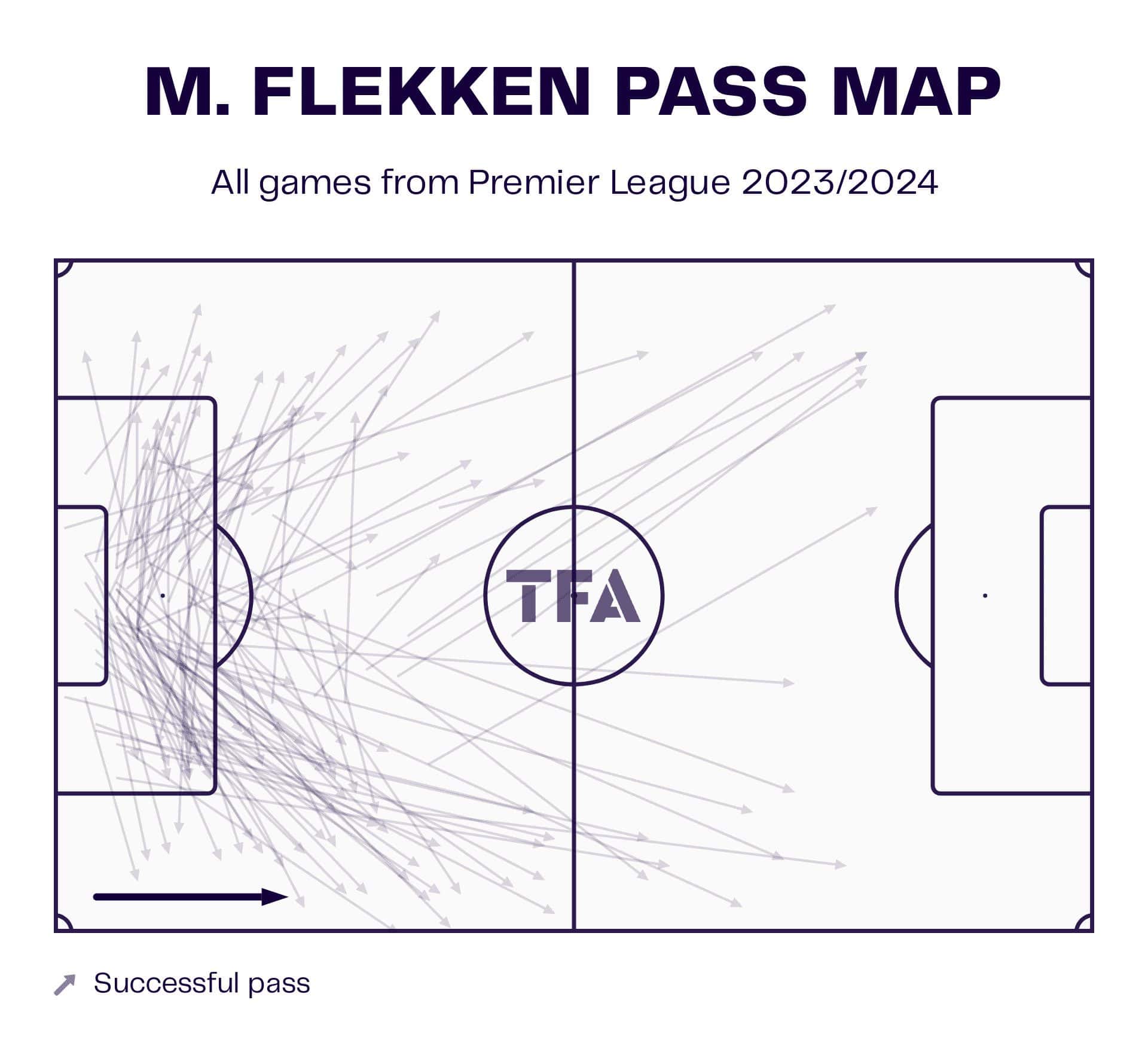
In midfield, Jensen and Nørgaard, setting the tempo, seek rapid penetration through vertical progressive passes, isolating both wingers in space with opponents.
Moreover, Brentford excel at quick ball switching from side to side, leading the league in switches this season with 18, allowing them to change their attack’s starting point effectively.
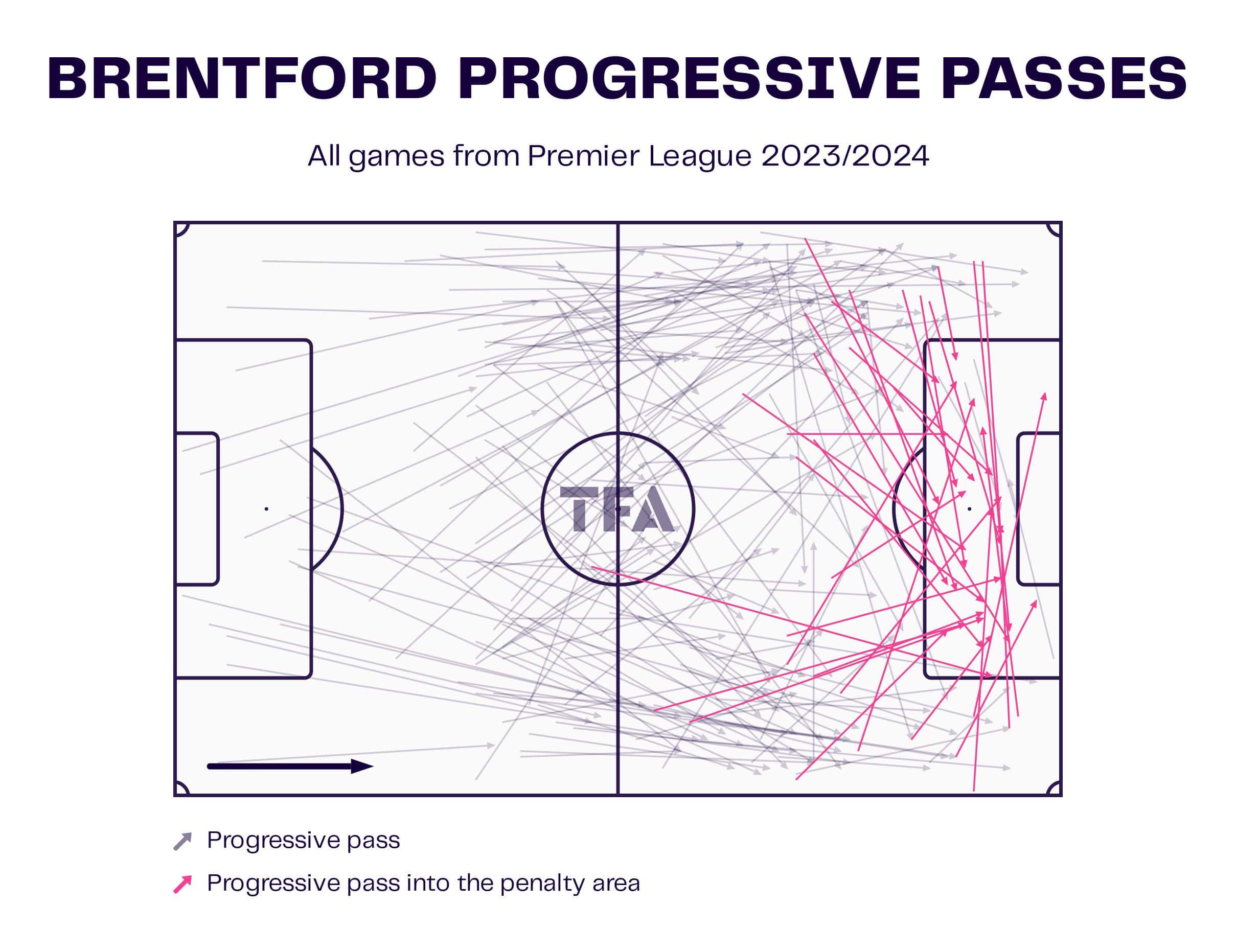
A key aspect of Brentford’s approach is fast and direct play into the spaces behind the opponent’s defence. This was evident in a recent match against Bournemouth: Under aggressive pressing, Flekken launched a long ball to Mbeumo, who quickly dropped the ball to right-back Hickey.
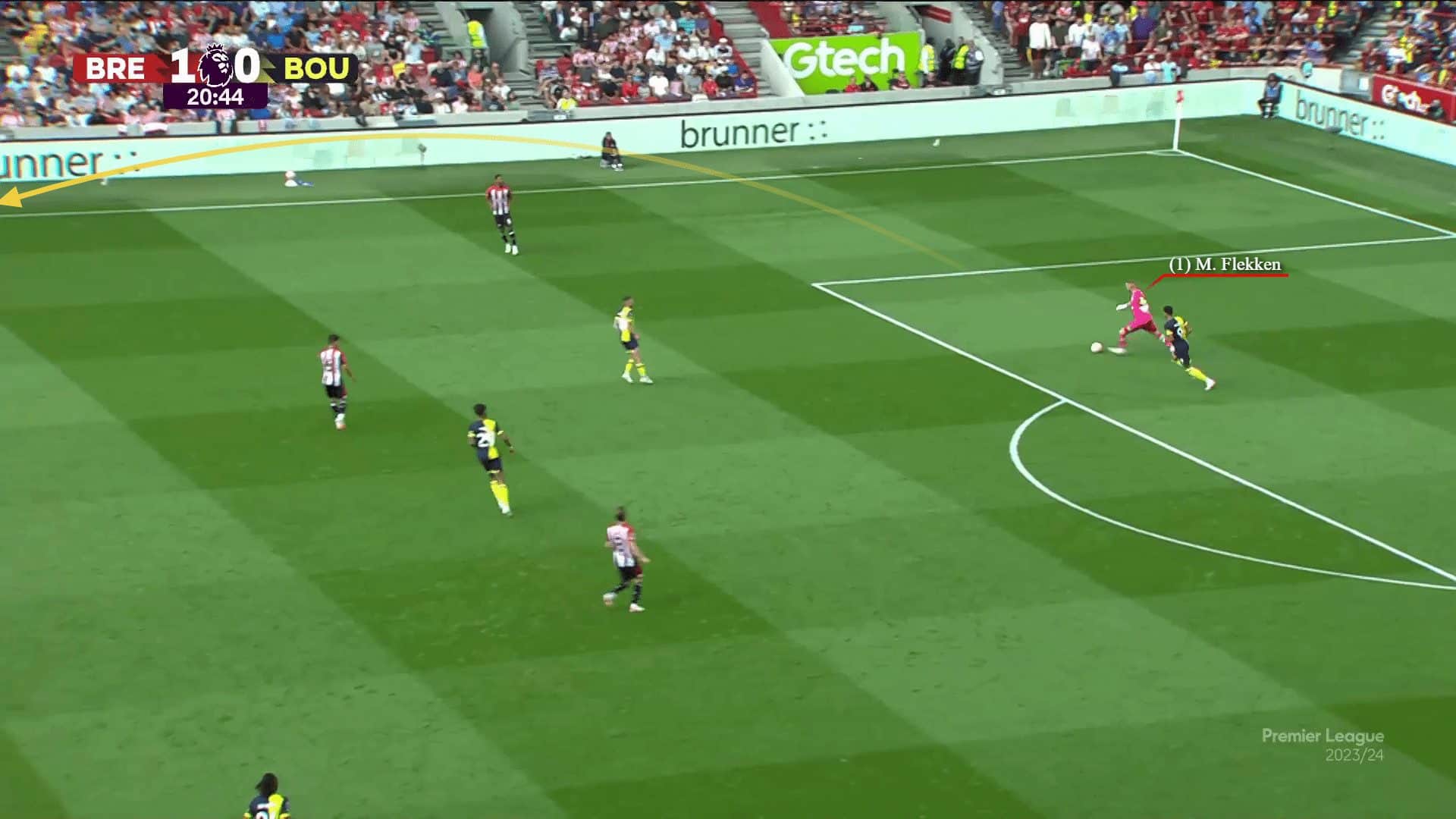
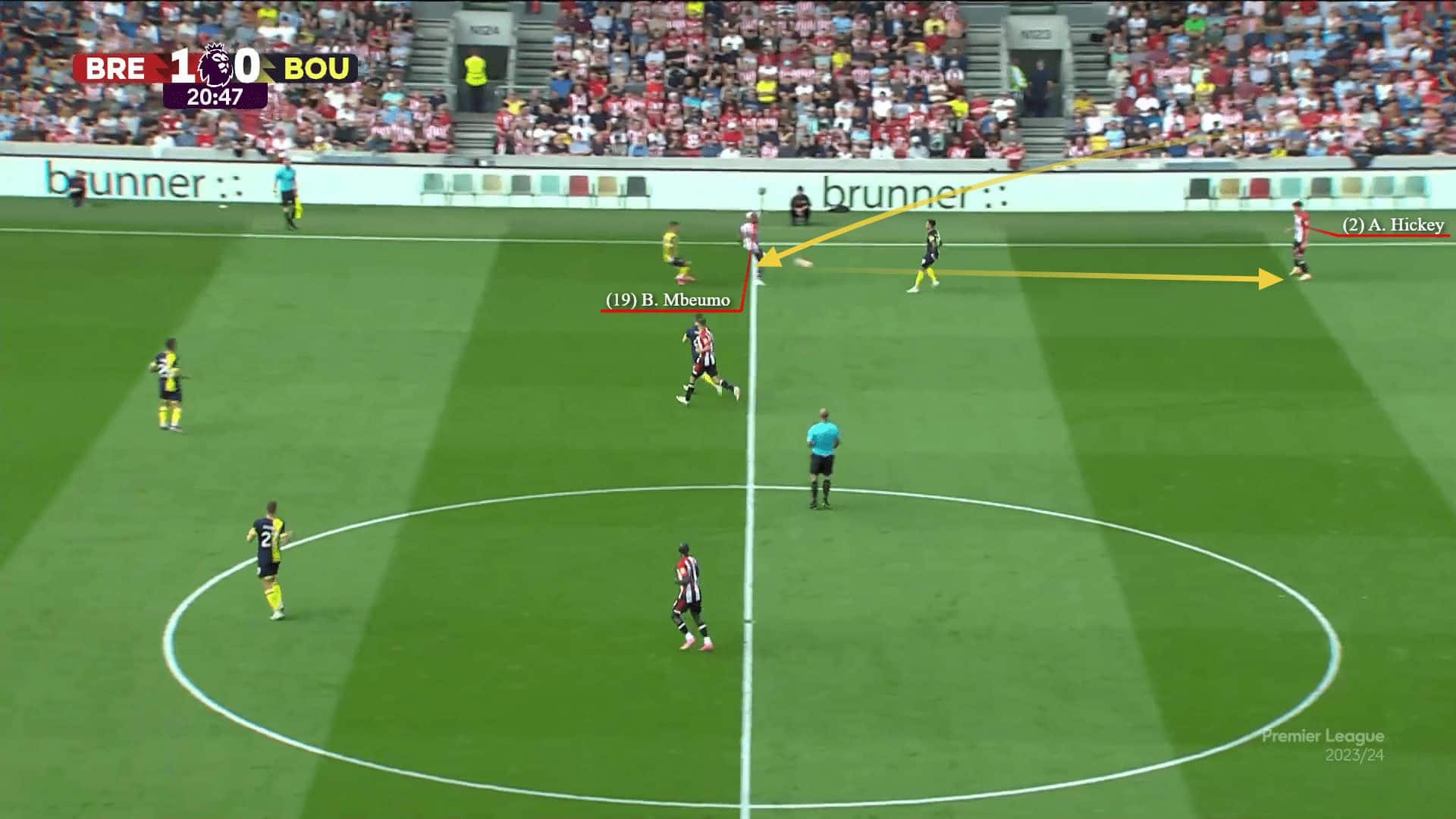
After that, Jensen received the ball and passed it to dropping-off striker Wissa, who added +1 deeper passing lane, created space and dragged a defender with him. Wissa then passed to Nørgaard.
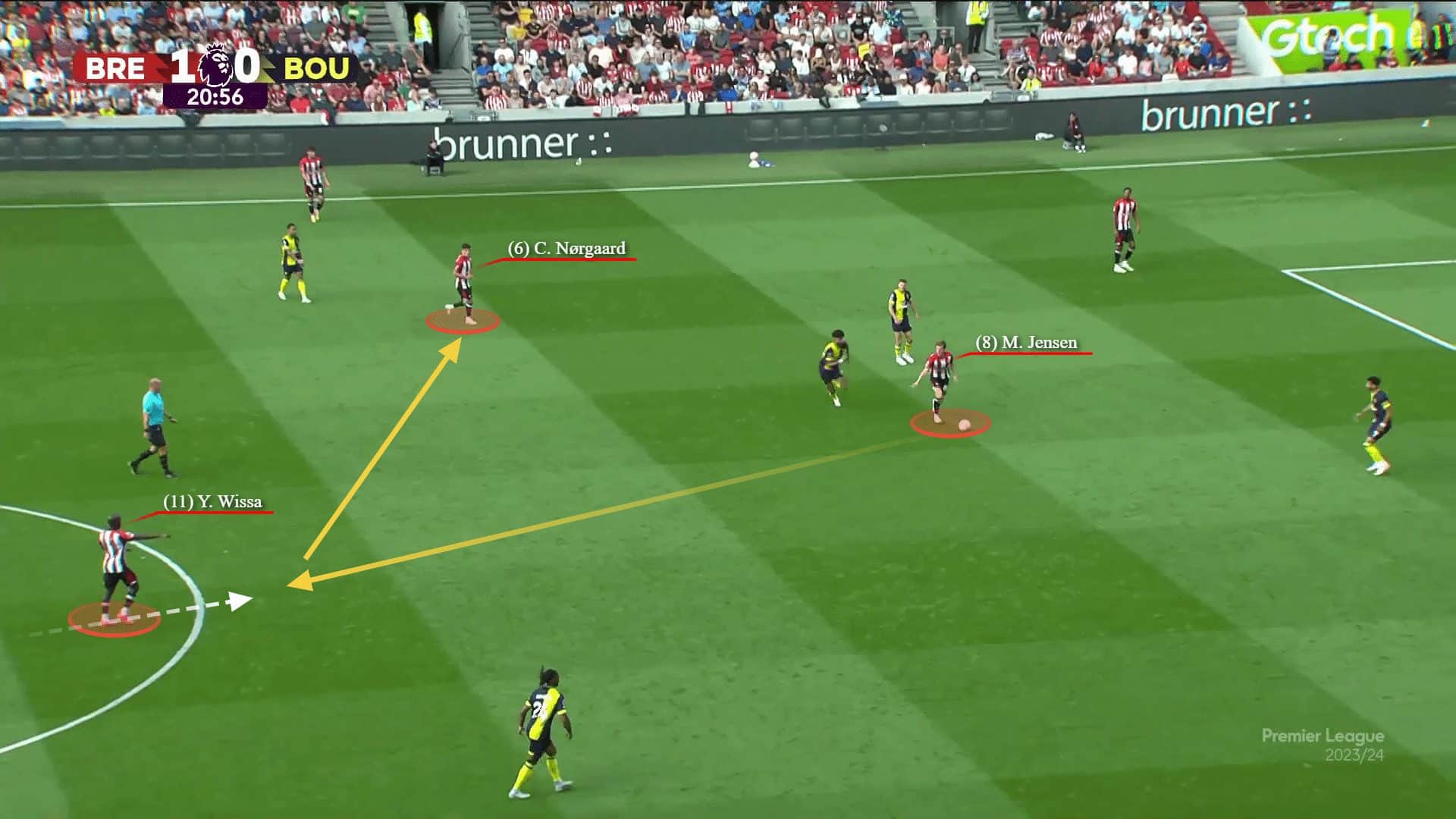
Nørgaard executed a 1-2 combination with Jensen, provoking the other centre-back to move higher and leaving the back line in a 2-on-2 vulnerable situation.
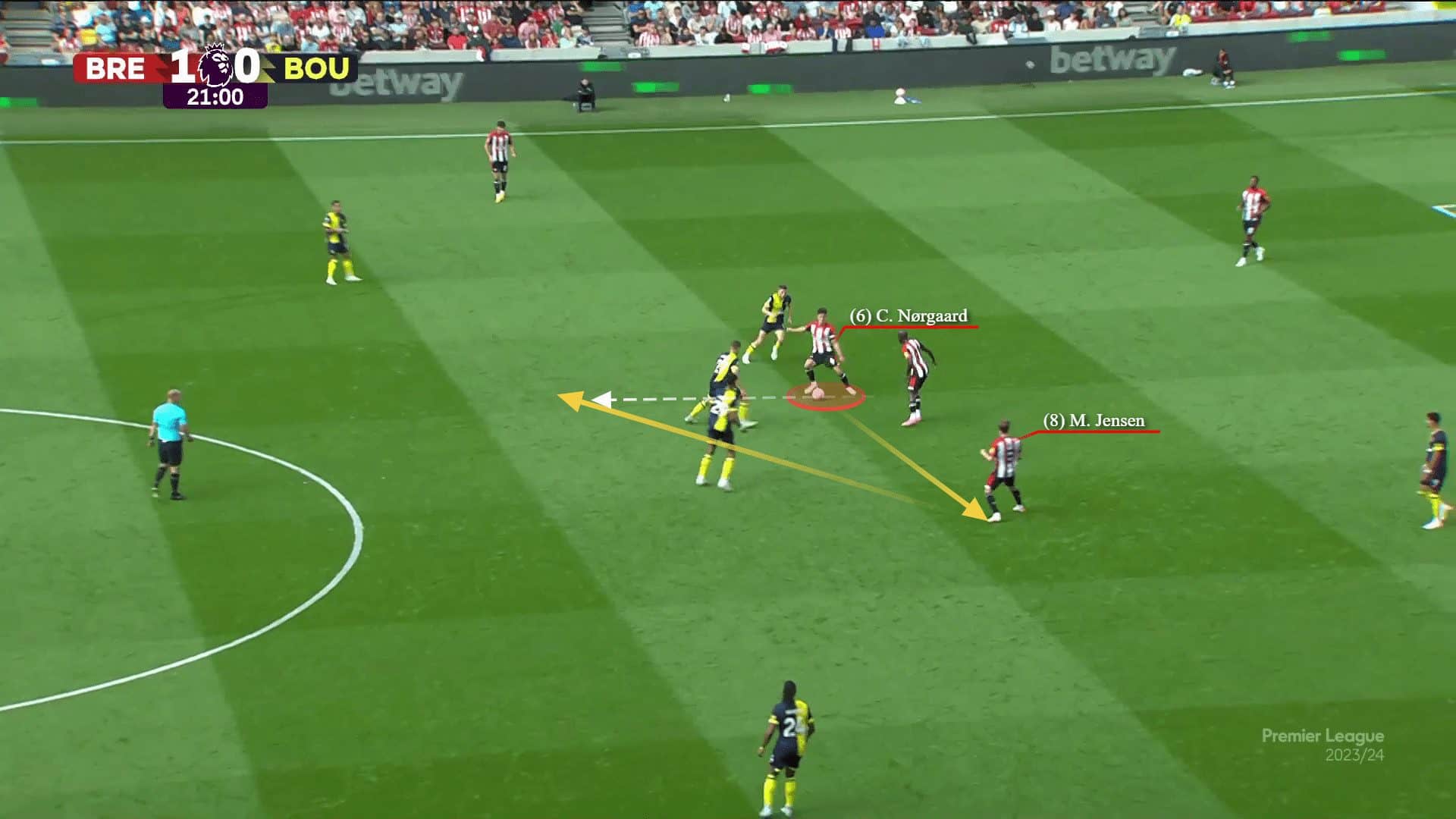
Nørgaard played a long ball to the inward winger Schade, who timed his run perfectly, gaining the upper hand over his marker. Schade had a one-on-one opportunity with the goalkeeper but missed on the right post.
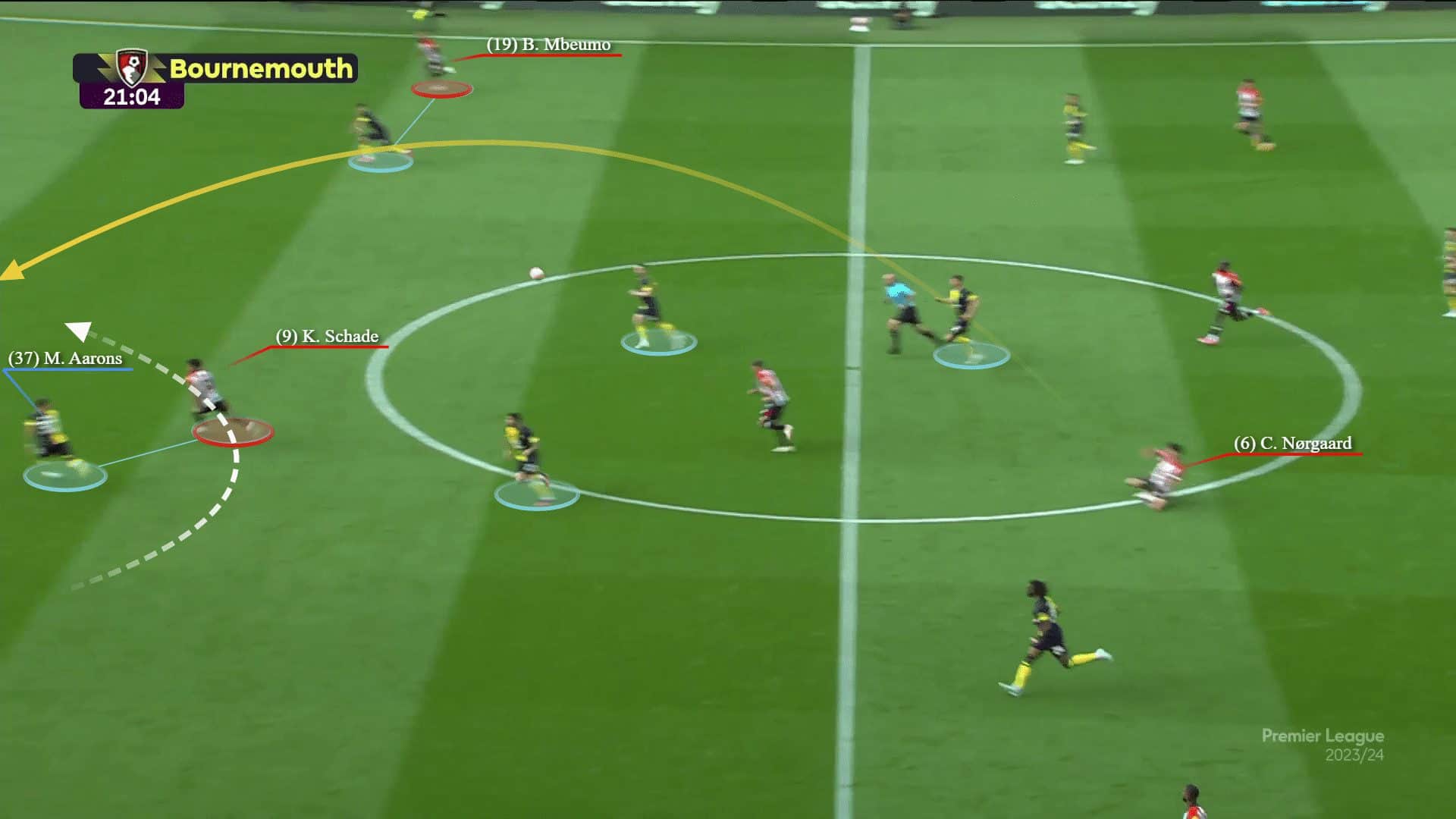

Kevin Schade possesses tremendous potential in speed, accuracy, acceleration, and timing in attacking the half-spaces or the defence’s blindsides. With time, his skills are likely to develop further and mature, but he is very striking even after just four matches.
Furthermore, counterattacks serve as a potent weapon for Brentford. The team maintains its rapid pace and element of surprise, often opting for vertical progression instead of continuing with slow possession.
An excellent example of Brentford’s counterattacking prowess was displayed in the same game, particularly in the late second goal.
Collins received a long ball from Bournemouth’s goalkeeper, and at the same time, Bryan Mbeumo positioned himself slightly wider than the full-back.
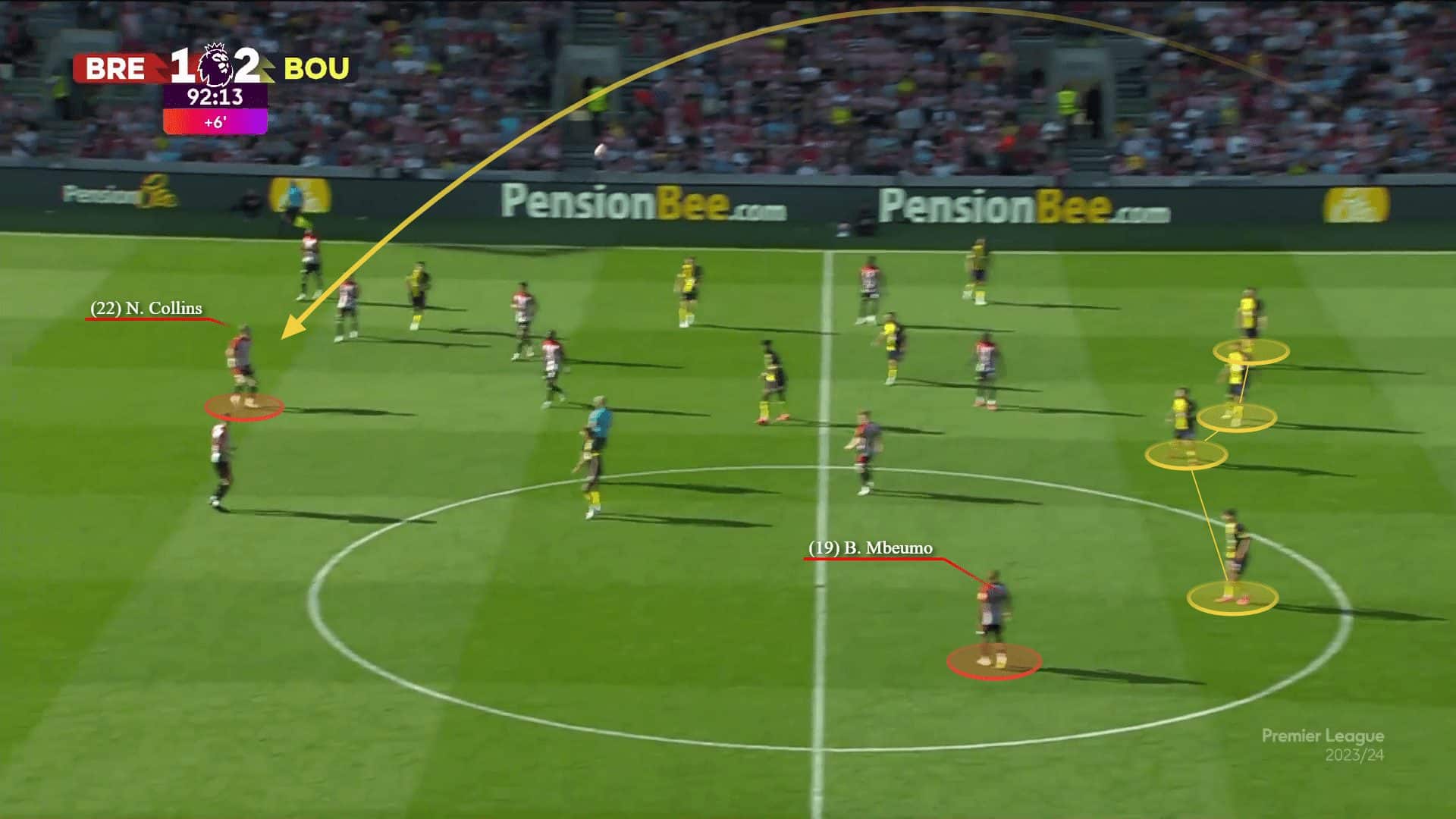
When Collins received the ball, he initiated a rapid counterattack by playing a long ball behind the defence, targeting the advancing Mbeumo. Mbeumo executed a skilful turn to shake off the defender.
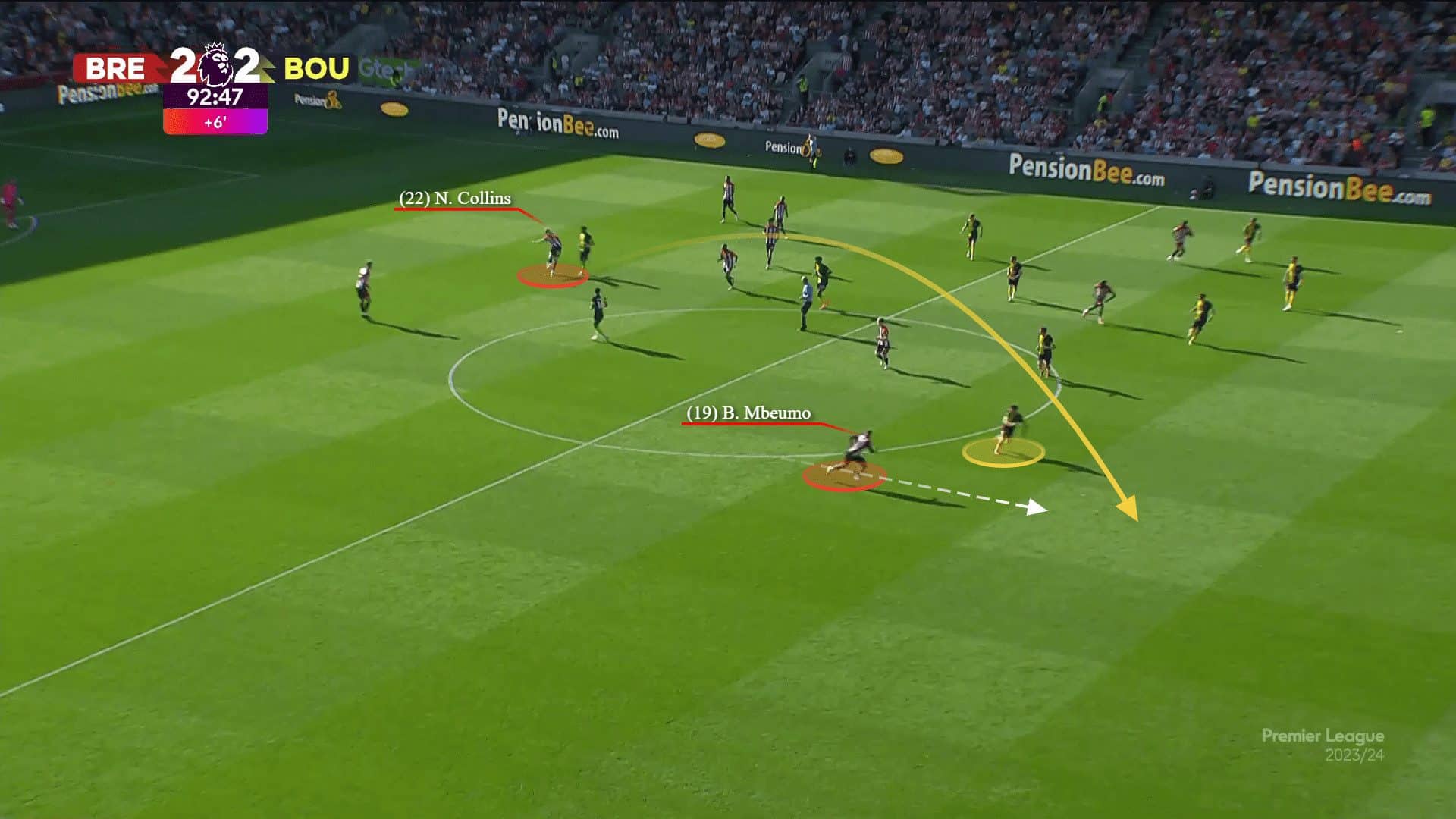
This sequence left Mbeumo one-on-one with the goalkeeper, and he calmly scored the equalising goal.
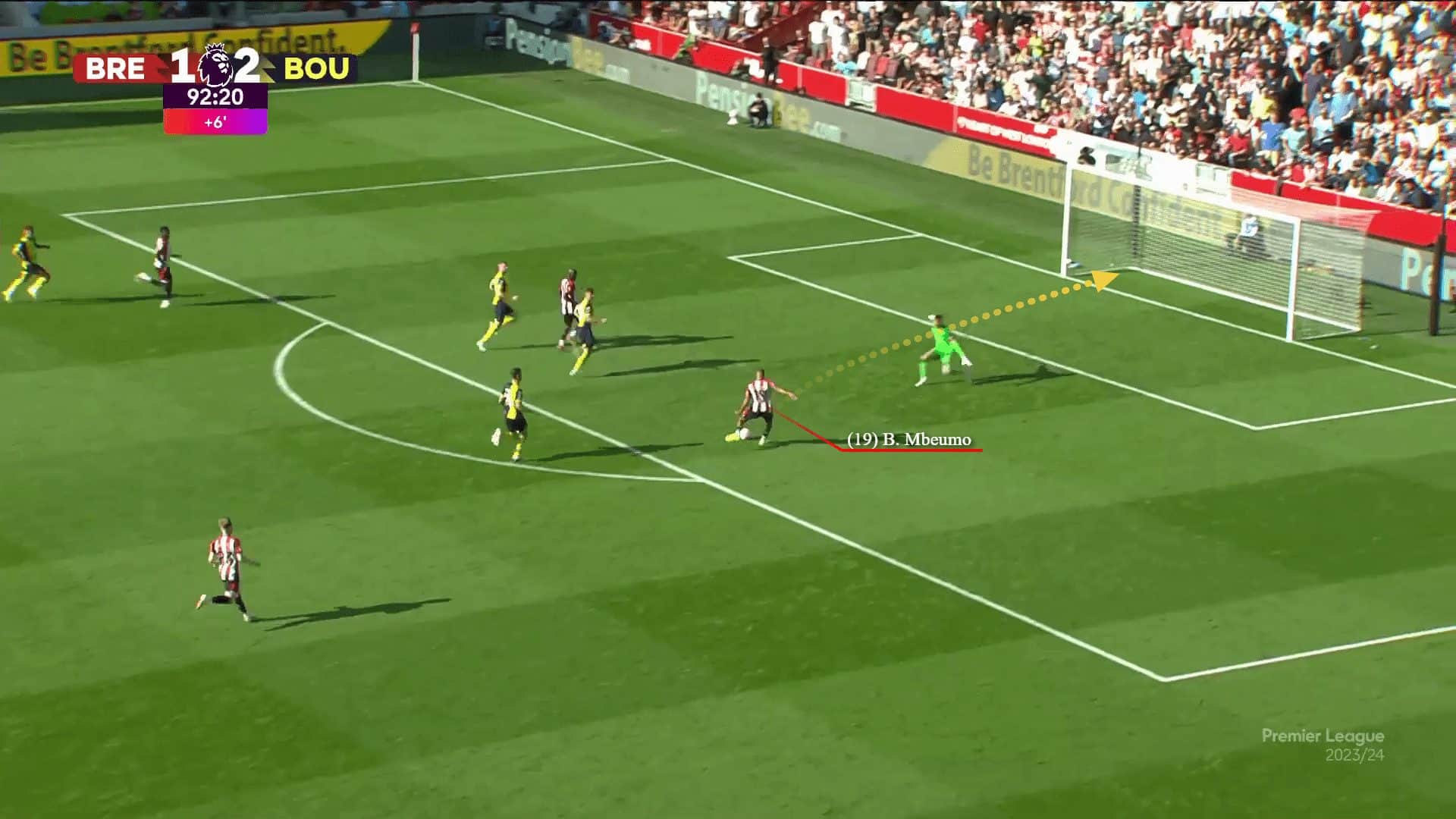
Brentford’s ability to swiftly transition after winning possession is a recurring and effective facet.
From isolating wingers to cutbacks
Another idea is the quick play switch to change the attack’s starting point, isolating a winger in a 1v1 situation.
This was evident in their goal against Crystal Palace, where they faced central pressure. Nørgaard dropped deep to the first line, a recurring tactic as both he and Jensen possess the vision and ability to create from deeper positions. This also allowed Henry to advance either overlapping or underlapping.
This change provoked Pinnock to pass the ball to the right side, where Hickey was expected to face immediate pressure.
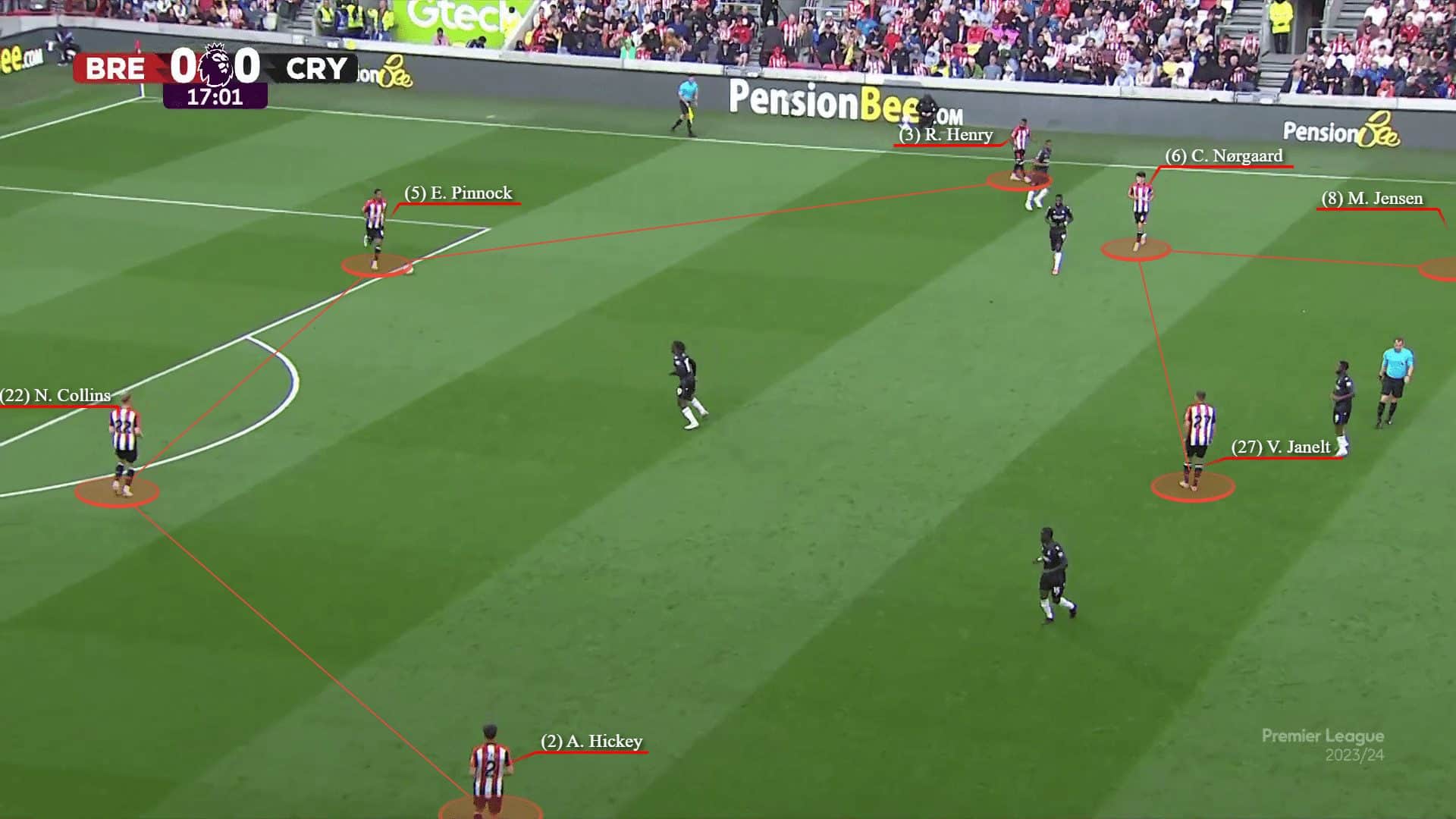
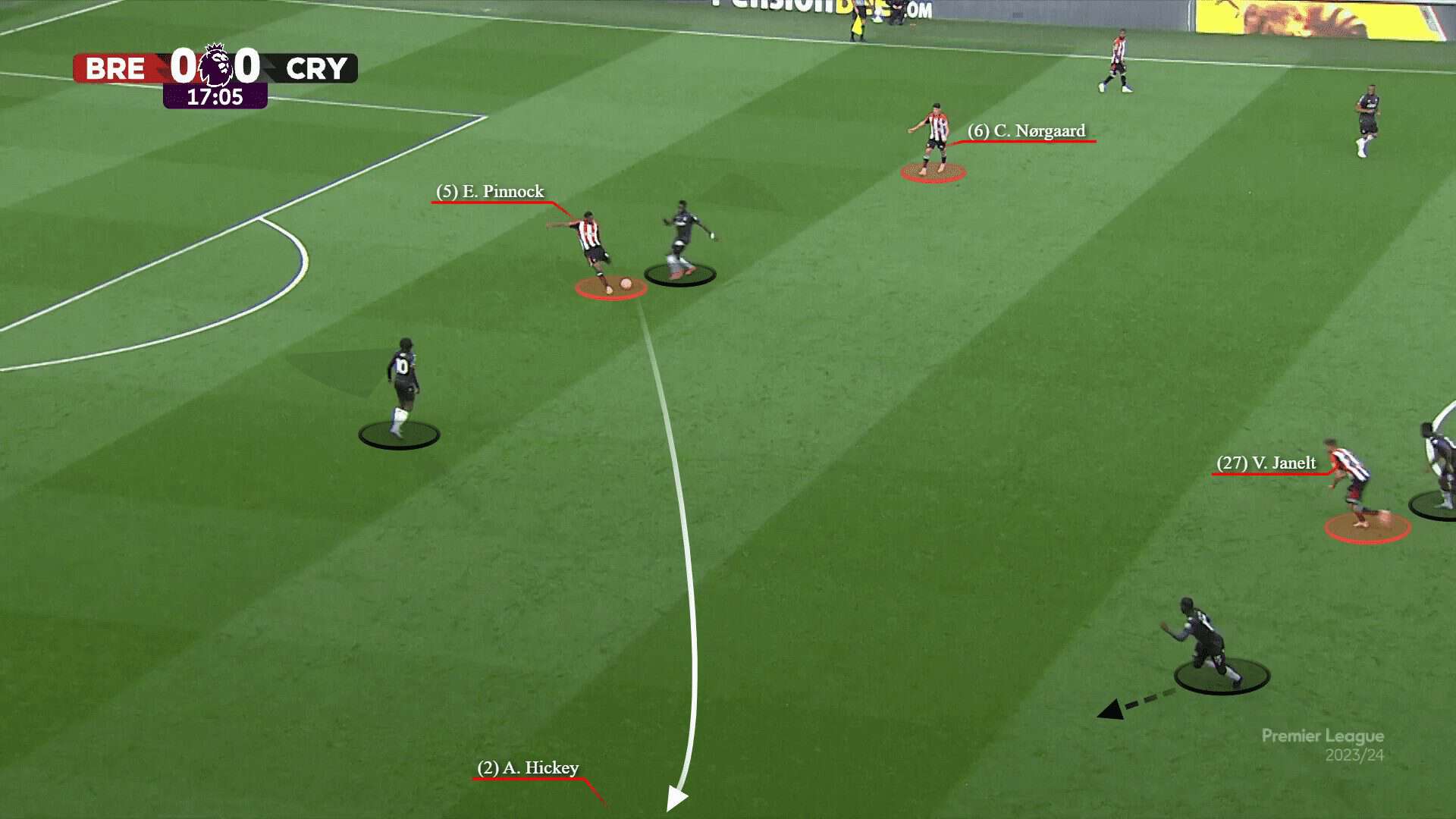
Hickey cleverly drew his marker in while Collins moved out wide to create a free passing lane for him. This led to a third-man combination, granting access to Nørgaard in the middle, with Janelt pulling his marker out and creating additional space.
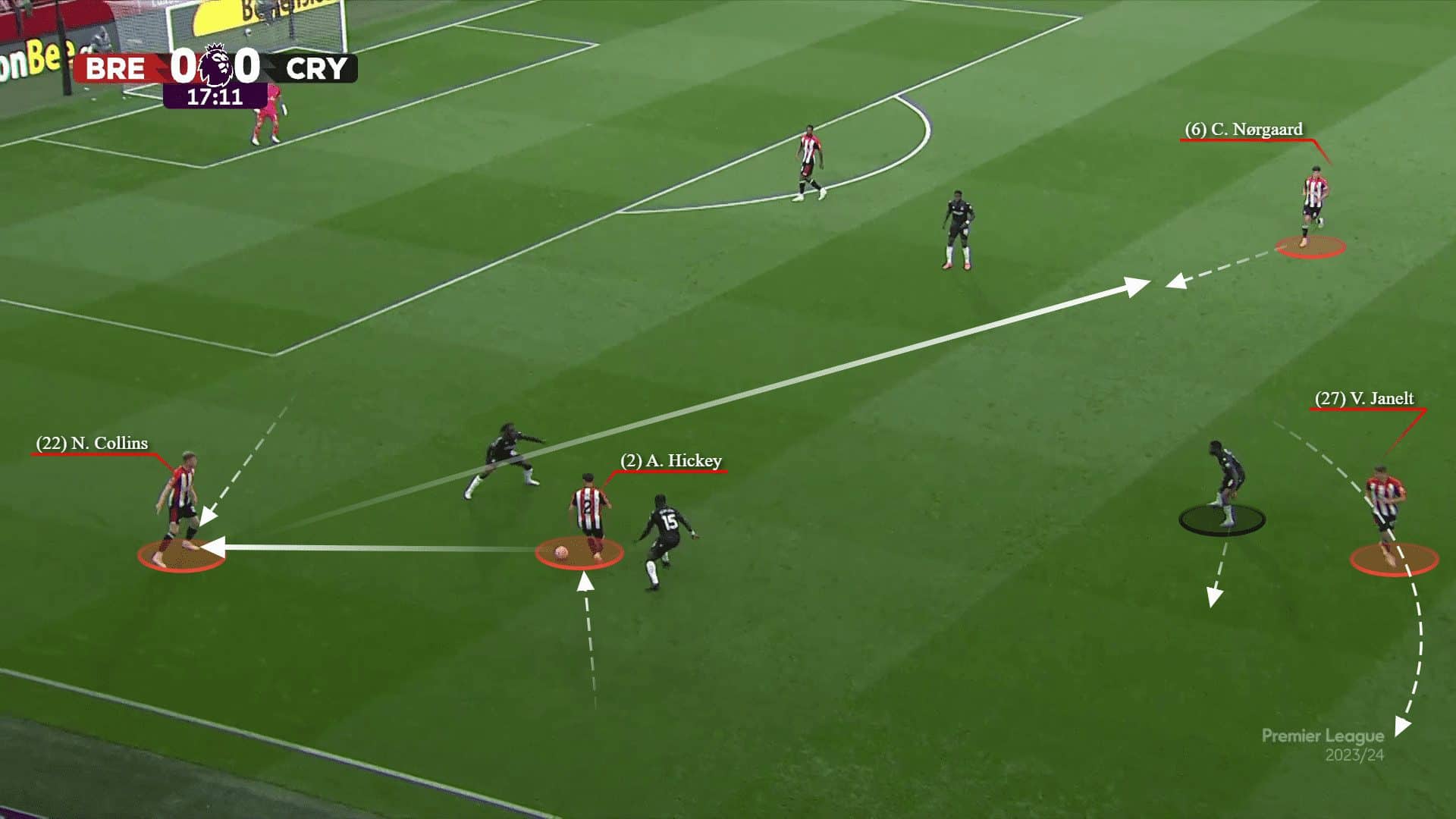
Nørgaard, from this position, decided to switch the play to the left side, where Kevin Schade awaited. With Wissa positioned in the half-space, he confused the opposition’s full-back, allowing Kevin Schade ample time to receive and control the ball.
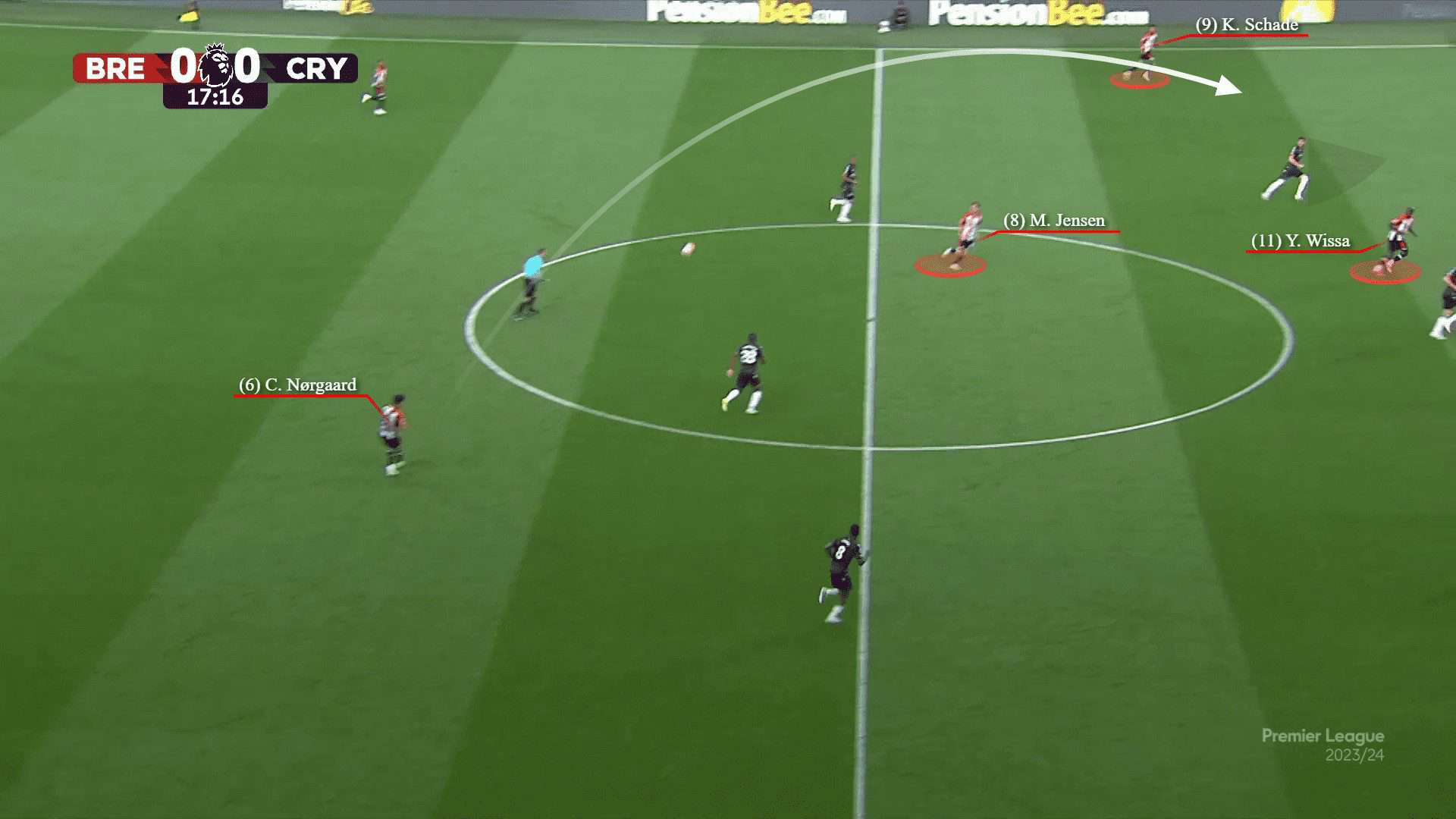
Both No. 8 typically move quickly to position themselves near the edge of the area, anticipating any cutbacks. In this scenario, Jensen’s movements confused three defenders, isolating Schade with the full-back.
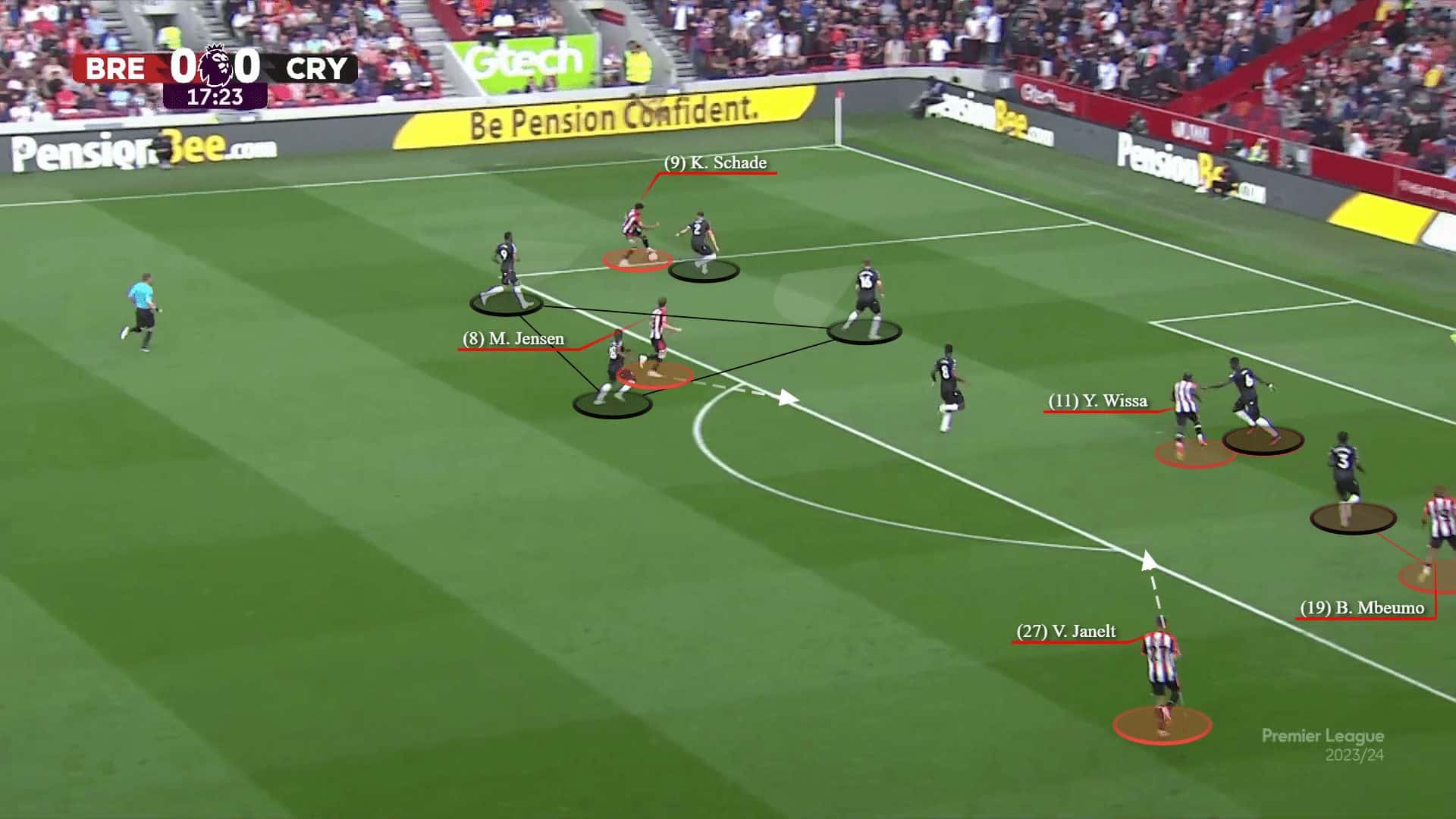
With great skill, he dribbled inside, created a shooting angle, delivered an excellent curved ball, and scored a goal.
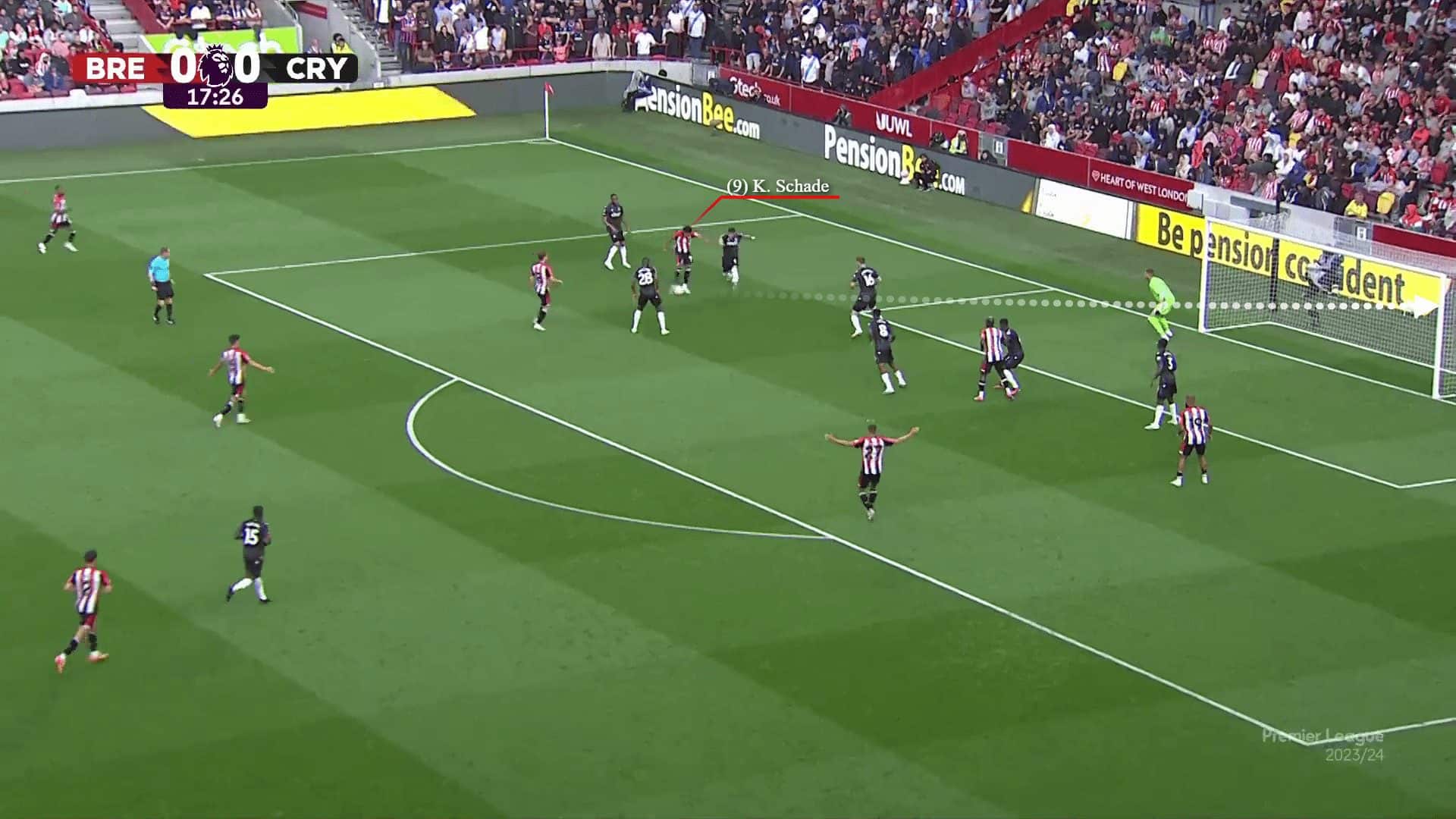
Brentford typically operate frequent cutbacks and rapid, driven crosses, as depicted in the graphic below, highlighting their approach during the first four matches of the season.
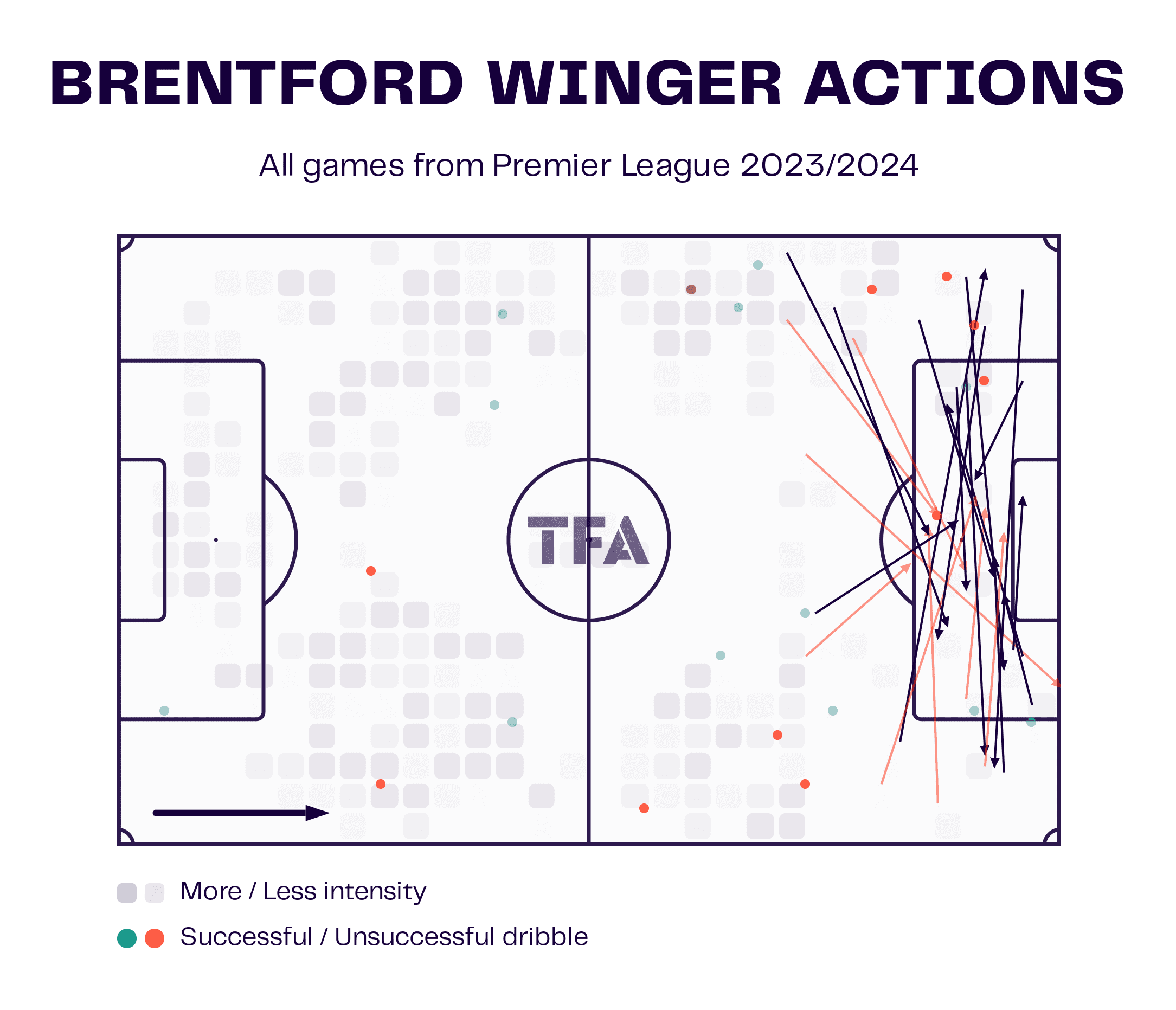
In the match against Spurs, which ended in a 2-2 draw, Nørgaard displayed exceptional anticipation and awerence. He successfully moved and controlled the ball after a challenge between Wissa and Sánchez.
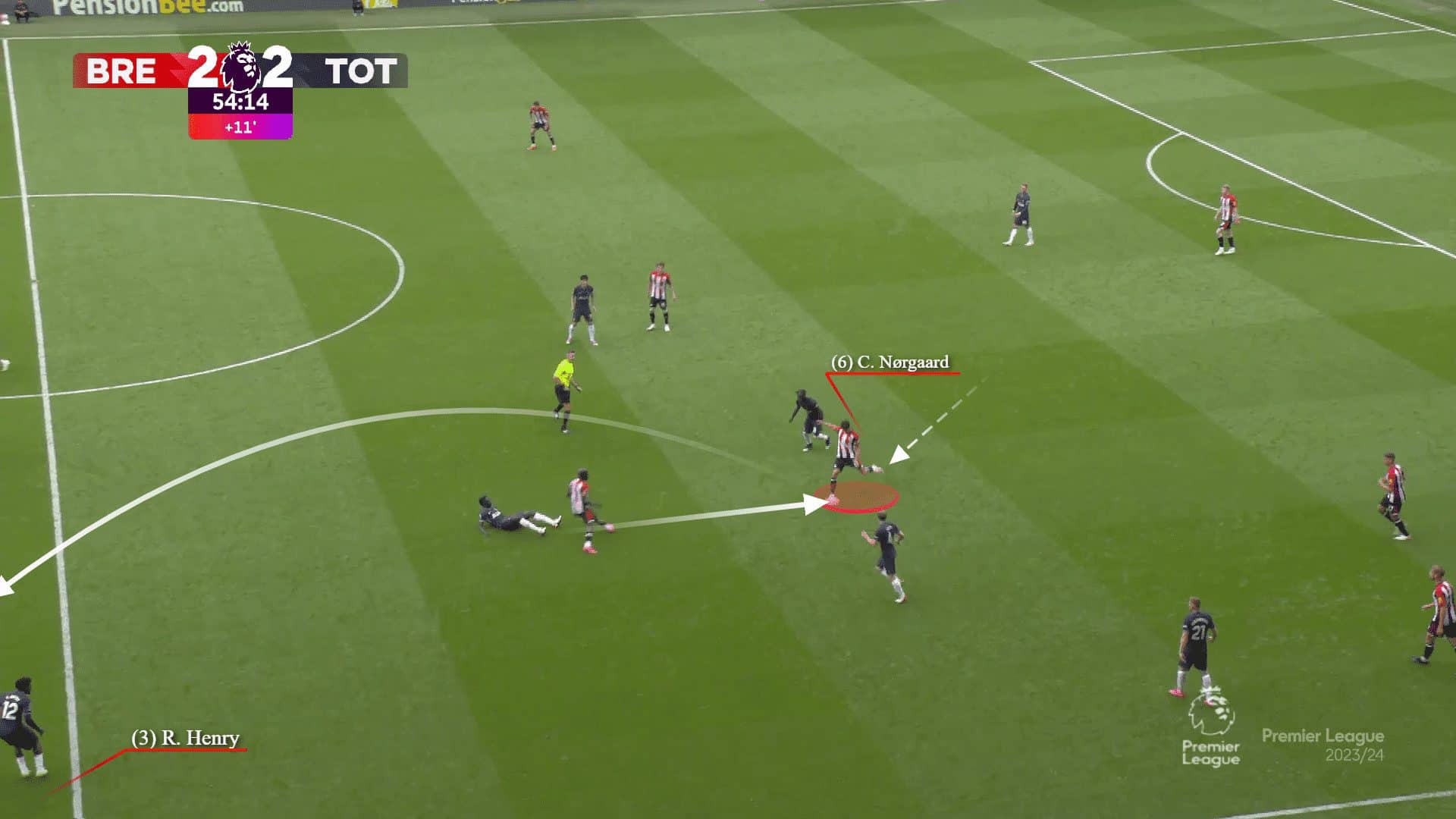
Without hesitation, he launched a direct long ball behind Tottenham’s defensive line to the wing-back Henry. Simultaneously, Mbeumo initiated his run towards the far post.
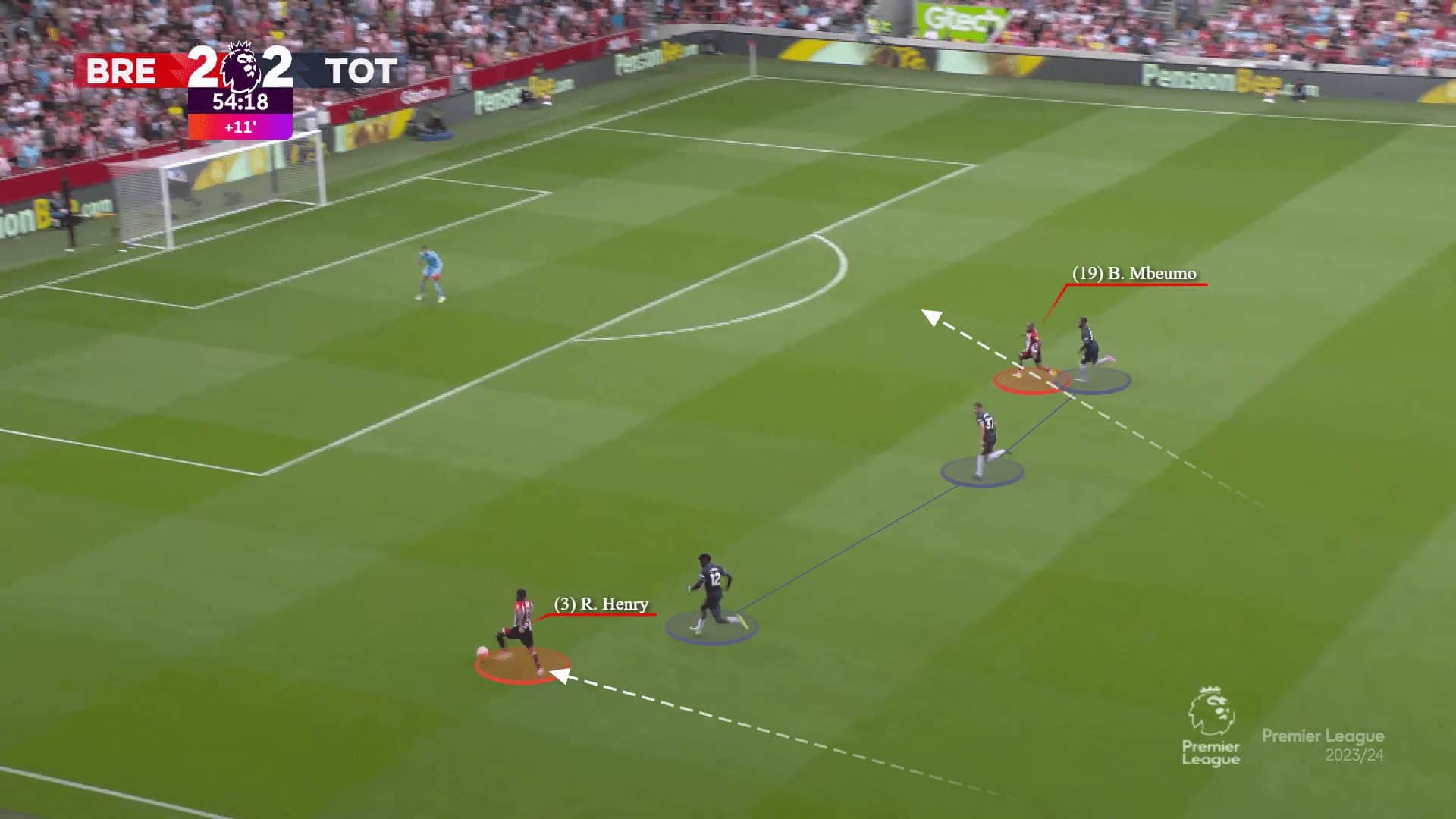
Henry swiftly delivered a driven cross towards the farthest point, where Mbeumo positioned himself as he approached the box. Unfortunately, Mbeumo missed what seemed like a straightforward scoring opportunity.
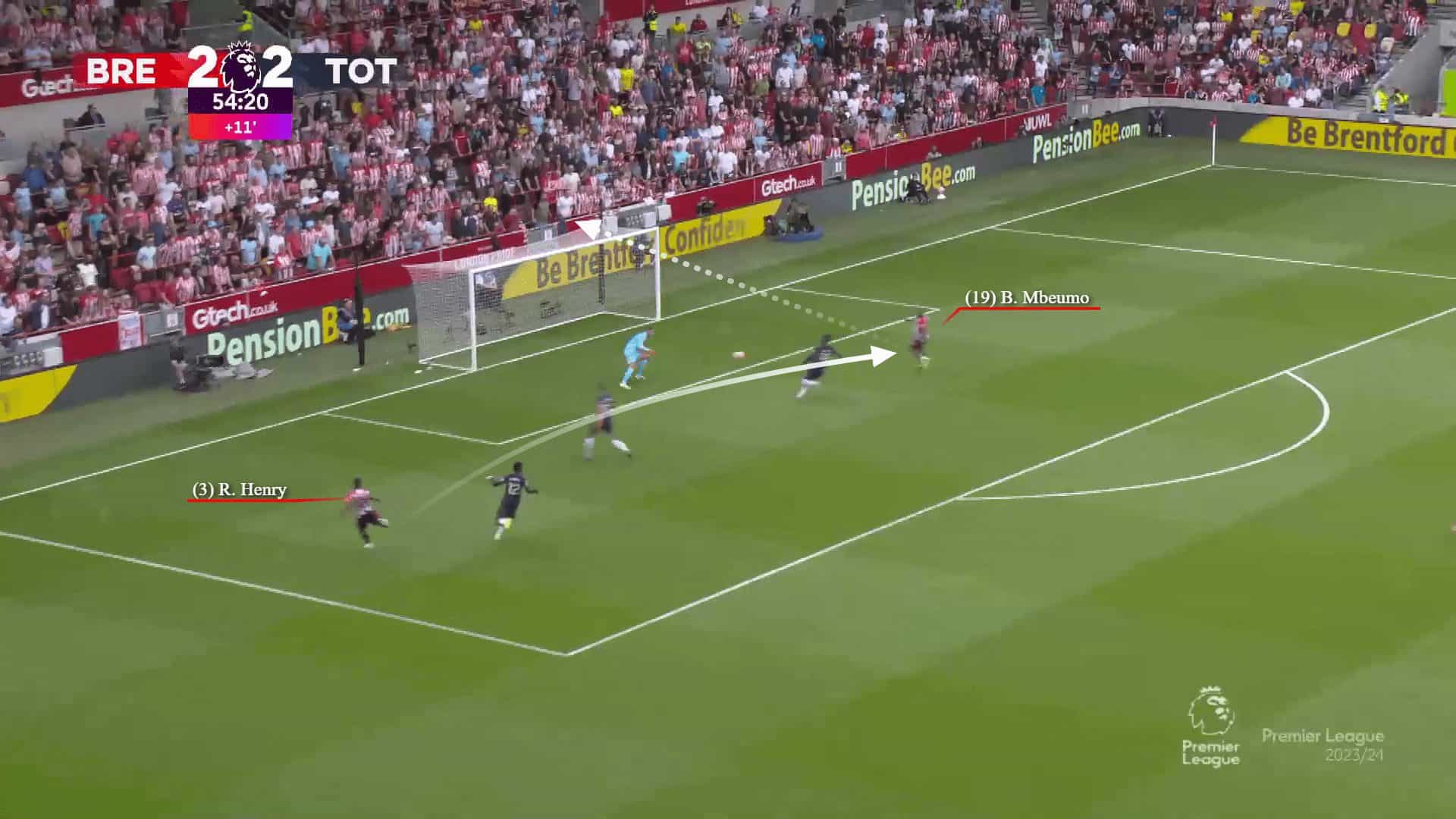
Despite his experience and significance to the team, Bryan Mbeumo has yet to ascend to superstar status within the squad, which occasionally results in him squandering opportunities. Mbeumo struggles with consistency when it comes to converting prospects into goals.
Set pieces remain a crucial aspect
Brentford’s increase in their xG digit can also be attributed to their proficiency in set-piece routines, a strength they have displayed consistently over the past two seasons. The team heavily relies on set pieces, and their repertoire is impressively diverse.
One standout example occurred in their match against Crystal Palace. The key concept here is exploiting the flicking zone during corner kicks. Brentford used Mbeumo’s inswinging delivery to target this flicking zone, aiming to redirect the ball to the far post.
In preparation for a short corner, Brentford positioned four players close to the corner taker. At the same time, others waited on the far post, leaving the near post empty for dynamic utilisation. Meanwhile, Crystal Palace employed a combination of zonal and man-marking approaches.
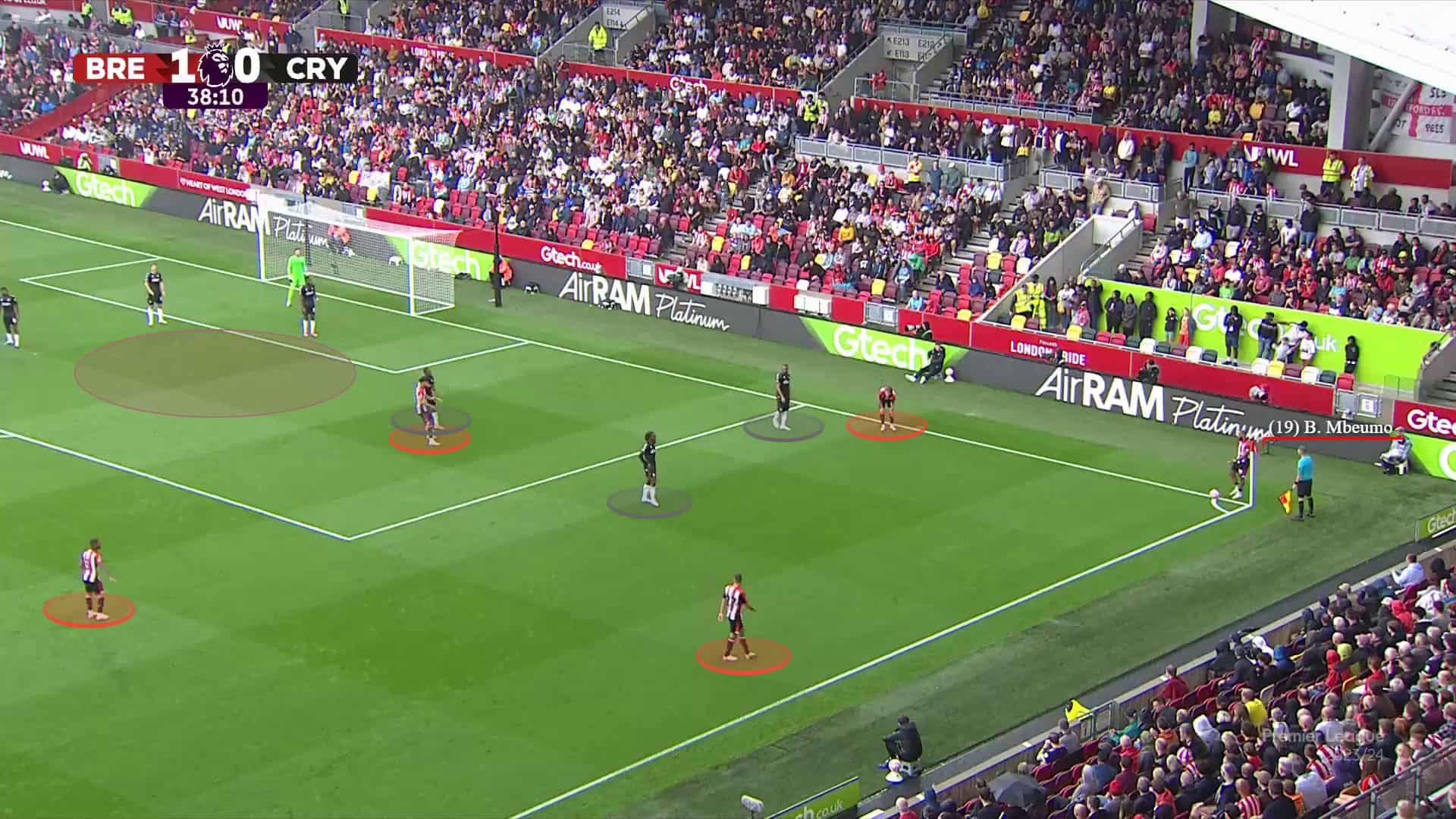
During the corner beginning, Schade retreated to the box and cleverly altered the direction of his run towards the near post, outsmarting his marker. Simultaneously, two more players moved toward him from the far post, forming a line near the near post.
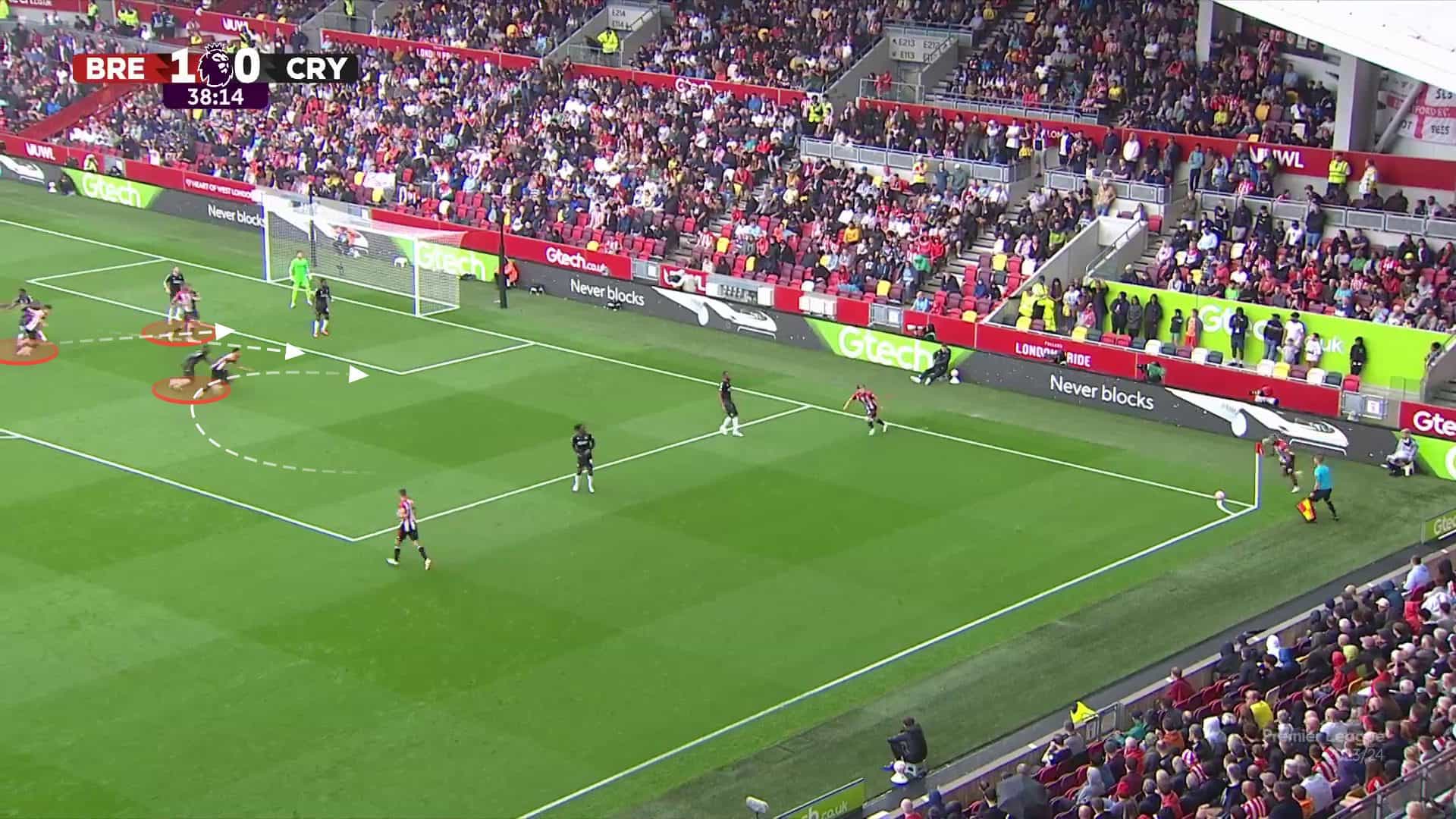
Yoane Wissa succeeded in dis-marking sufficiently and started to attack the space in the far post while his teammate didn’t.
Schade executed the flick, but unfortunately, Wissa missed the opportunity, resulting in an xG of 0.24.
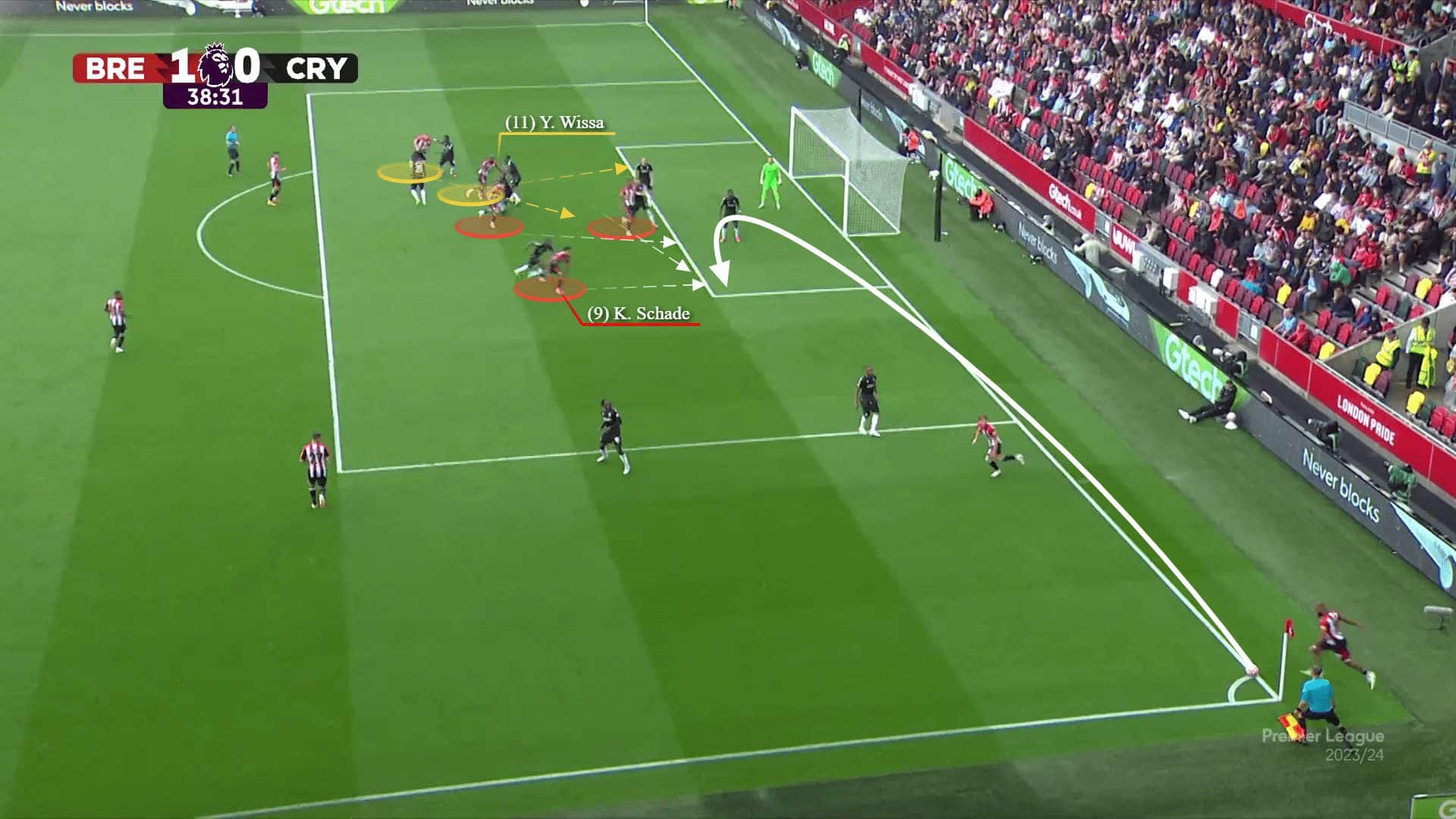
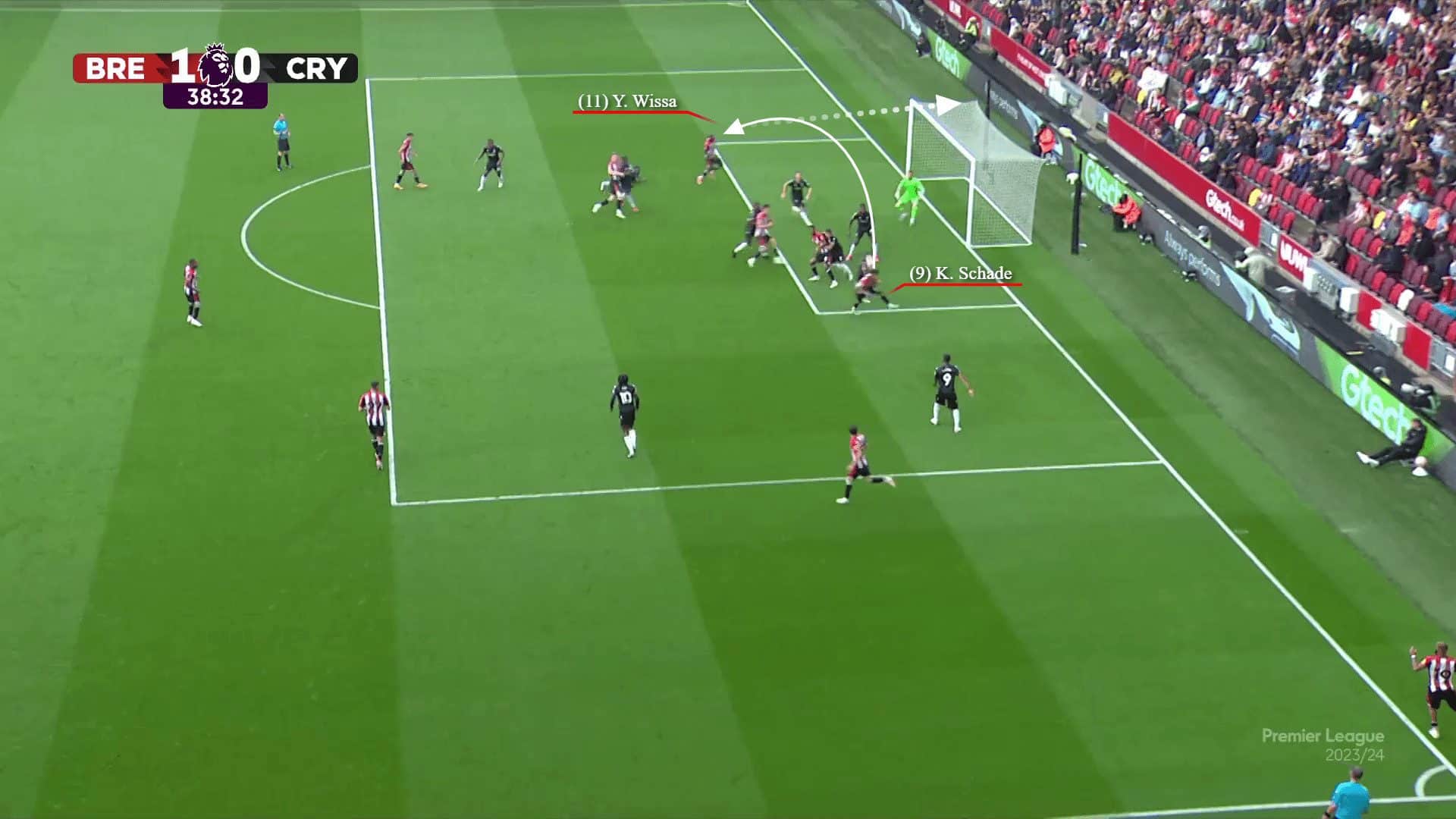
Conclusion
This tactical analysis and team-focused scout report of Brentford’s attacking tactics for the current season highlights the adjustments made in response to Toney’s absence. The analysis illustrates this challenge; the team continues to generate numerous scoring opportunities while adhering to their core principles.
The rejoining of Maupay will be closely watched to see if he can address the issue of missed chances and narrow the gap between actual goals scored and expected goals.
In the upcoming season, Thomas Frank faces guiding Brentford towards European competition, potentially aiming for a tournament like the UEFA Europa Conference League. It will be exciting to see how the team evolves and competes on the European stage.





Comments